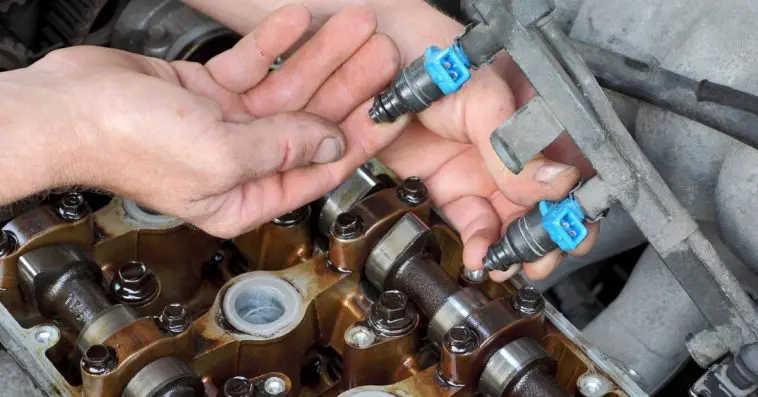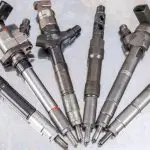Just like any component of the vehicle you own, the fuel injectors will need to be replaced at some point.
They will need to be replaced if you notice that there are some complications with the way the car engine responds.
Common signs that will show that you need to replace your fuel injectors are when the vehicle engine has poor starts, violent idling, and also misfires frequently; which are caused by the inability of the fuel injector to provide a consistent amount of fuel to the engine.
Here’s how you can replace worn out or damaged fuel injectors by yourself which is less costly.
You can do this by:
- Testing The Performance From The Fuel Injectors
- Getting Rid Of The Pressure That Has Built Up Along The Fuel Lines
- Disconnecting The Fuel Rails
- Undo The Fuel Injector
- Pull Out The Fuel Injector From Their Position
- Put In Place The New Fuel Injector
- Check For Leakages From The New Fuel Injector
- Test The New Fuel Injector
Replacing fuel injectors is not a demanding task but you should be able to get it done in less than an hour provided you have the tools that are required.
You will need a little bit of skill to get the replacement done.
TABLE OF CONTENTS
When To Replace Your Fuel Injectors
Fuel injectors may be subjected to some elements that make them less capable of dispensing a sufficient amount of fuel to the engine.
Either of these causes it to be less precise in its work and thus will need replacement.
Replacement of the fuel injectors will be needed if you notice any of the following signs:
- Restrictions: If a single fuel injector can cause a restriction in between the range of 8% and 10%, a misfire can be caused. The unburnt oxygen makes its way to the exhaust and the sensor indicates lean.
For the direct fuel injectors, they are less susceptible to restrictions as they let in precise fuel proportions through to the combustion chamber. - Turbo Complications: For the turbocharged engine types, fouled injectors have a negative leaning effect that interferes with the normal working of the engine.
The fuel injectors lead to the leaning of the air and fuel mixture that is unable to meet the demands of the engine and this might cause detonation.
This then leads to turbo complications/failure and high temperatures from the exhaust of the vehicle. - Heat Soak: After the engine is shut off, heat soak affects the fuel injectors and this leads to the formation of deposits on the fuel injectors which cause them to clog up and unable to let through enough fuel to the engine of the vehicle.
This will then lead to the inability of the fuel injector to do their work as needed. This also happens for the new vehicles that have lower mileage coverage since the short driving cycles and an increase in heat soaks can also clog the fuel injector. - Irregularity In The Fuel Trims: You might realize that the fuel trims are affected by either increase or decrease in their long term and short term fuel trims.
This is usually caused by the injectors being clogged and unable to deliver enough fuel or even that leakages in the fuel injectors. - The Resistance Is Not Up To Par: When you use an ohmmeter to check for the fuel injector and you notice that there is not enough resistance then the fuel injectors might not be able to do their work.
The ohmmeter should be able to single out the faulty fuel injector and which needs to be replaced for the optimal performance of the engine’s vehicle. - Unusually Longer Crank Periods: If a fuel injector is affected with leakages, the rail will lose pressure as the vehicle is resting. As such, long crank time will be needed for the rail to pressurize.
- The Engine Fails A Balance Test: An injector balance test is used to single out the bad fuel injector. This will be the case if you suspect that one injector is clogged or not able to function as needed.
- Codes Of Misfiring: A lean misfire from the engine may provoke a misfire code and the engine light may be triggered to light.
- The Inability Of The Vehicle To Start If The Fuel Tank Is Full: Most signs of contamination of the fuel used in a car are shown just after you have refueled.
If this is the case, the fuel injectors might not be doing their job as appropriately as they need to. - Poor Maintenance Or None At All: Some vehicle owners ignore maintenance practices on their vehicle. They rarely change the oil or even change the filters.
If the oil is not changed in the case of a direct fuel injection engine, this may lead to wearing out of the fuel pump camshaft lobe.
8 Steps To Change Your Fuel Injectors {Let’s Learn Deeply!}
If within the past few weeks, you notice a poor performance from your engine-it has poor starts, rough idling and you also have to refill the tank often, then the issue might be with the fuel.
If you also notice that your vehicle’s interior is filled with the odor of unburnt gasoline, then it is time you replace your fuel injectors.
If the fuel injectors are damaged, they are unable to provide consistent amounts of fuel to the vehicle’s engine and thus the mixture of air and fuel is not burnt at appropriate proportions.
You can replace fuel injectors through the following procedure:
1. Testing The Performance From The Fuel Injectors
The first step before you even get new fuel injectors is to test the fuel injectors that are currently fixed on your vehicle’s engine.
You can get this done by feeling for vibrations from the engine. If there are unusual noises and vibrations, the fuel injectors might not be in their best condition.
An ohmmeter can also be used to check on the performance of fuel injectors. You should be able to use it through the simple instructions of how to work it.
You can also look out for the engine light on the dashboard, if it is on, then the fuel injectors might be to blame.
You can also test each fuel injector by disconnecting one, cranking the engine, and checking on how it runs. If the engine runs roughly then the fuel injector might not be damaged.
However, if you are unable to spot any abnormalities with the way the engine runs, then that particular fuel injector is damaged.
2. Getting Rid Of The Pressure That Has Built Up Along The Fuel Lines
You can release the pressure that builds upon the fuel lines by loosening the valves that are located along the fuel lines.
A relief valve would do, but if you can’t find one, you can always look out for a relay switch or a fuse that is found on the fuel pump.
You will need to crank the engine, let it operate for not more than a minute, and then take off the fuse.
The vehicle’s engine tends to run until the point when fuel along the fuel lines is completely used up.
3. Disconnecting The Fuel Rails
Some vehicles are designed with specific fuel rails that provide fuel to fuel injectors located in each of the engine’s cylinders.
Disconnecting the fuel lines on each fuel rail on both sides will get this done. The screws and bolts have to be removed for all the wiring to be undone.
Next, the fuel rails have to be removed gently to avoid damage to the fuel injectors in any way.
For some vehicles, they are not designed with a fuel rail and you should just proceed to remove the fuel injectors.
They are usually clustered close together within the throttle assembly of the engine of the vehicle. An excellent idea is to consult the owner’s manual that comes with the vehicle.
4. Undo The Fuel Injector
Either of the fuel injectors connected to the engine of your vehicle should have a plug that is attached to a wiring harness.
The plugs on the fuel injectors have a springy wire that is used to secure it onto the position.
You can get rid of this wire quite easily using a screwdriver so that you can comfortably remove the fuel injector.
The screwdriver- a flat-tip one- is placed in the area between the plug and the spring, then nudge it so that the fuel injector is loose enough for removing.
5. Pull Out The Fuel Injector From Their Position
A caution that you need to observe is to remove the fuel injectors gently while avoiding the use of too much force.
If you are not careful at this point, the fuel rail may be damaged with the excessive force you apply while removing the fuel injectors.
For starters, the O-ring seals that are on the nozzles of the fuel injectors need to be inspected before you take any other action.
They should be complete, otherwise, the O-ring might still be in the intake manifold. If the O-ring is not complete, you first have to remove it from the manifold before any other step.
For some vehicle models. The fuel injectors are secured onto the fuel rail of the engine using a retainer.
The retainer has to come off first before any other step. You can remove them by rocking the backward and forwards in a gentle manner while avoiding damaging the rail.
After all these preparations, you should get a fuel injector puller and start pulling off the fuel injectors from their position.
You should also be gentle while doing this as too much force might cause them to break and some parts may fall onto the engine.
A fuel injector puller works to make your disconnection of the fuel injectors from their ports to be done much easier and also to avoid damage to the vehicle’s engine.
The last thing you want to deal with is damage to the engine of your vehicle. You can use it by sliding it just below the fuel injector housing’s lip and popping it out gently.
After you have successfully pulled out the fuel injector, the ports are seen as a large hole in the intake manifold of the engine.
You should be cautious not to allow anything to enter that space as correcting that will be quite stressful.
In the case of a throttle body, the disconnection of fuel injectors should be much simpler as all you need to do is pry them loose.
6. Put In Place The New Fuel Injector
If your vehicle is designed with a throttle body, the owner’s manual should have the procedure you should use to install new fuel injectors onto the throttle body.
However, you should not forget to put in place a new injector retainer bracket-but the original one can be retained if it is not severely worn out.
You should then tighten them, install the fuel injector harness, and connect the electrical connectors on the new fuel injectors.
For the most common types of vehicles that are designed with a fuel rail, the new parts need to be installed in the first place. The O-rings for the new fuel injectors are specific in this case.
You also want to clean the working area and get rid of any debris that is close by.
Position the fuel injector in the intake port of the engine in a careful manner, give it a simple push until it is secured in position.
However, if the intake manifold needs to be replaced or removed, the O-rings need to be replaced too.
This might also apply for the intake gasket which should be done before the intake manifold is placed back in position.
The fuel rails will also have to be installed over the fuel injectors and tightened with bolts and screws.
Make sure you reconnect the main fuel lines and some of the other staff that you had taken out in the first place when you were just beginning to replace the fuel injectors.
The same applies to the engine cover that you had removed when beginning this task.
7. Check For Leakages From The New Fuel Injector
The fuel injectors are connected to several features that fuel runs through-such as the fuel lines and the fuel rails that you had disconnected.
It would be a good idea if you inspected them for leakages before you wrap up. A combustible gas detector will help detect any leakages from the fuel line of the vehicle.
The fuel lines need to be filled with fuel to check for leakages. You should then proceed to ignite the car and be on the lookout for fuel pump activation.
You can then use the combustible gas detector to check for leakages, if you can’t detect any leakages, then you will be able to use the vehicle safely without risks of what leakages might cause.
8. Test The New Fuel Injector
You can then take your vehicle for a spin to check out the performance of your new fuel injectors along the fuel lines to the engine.
You should notice the significant difference that they bring to the table which should vary with the way your engine reacted earlier on.
For instance, the start should be much improved, the misfiring from the vehicles when accelerating should be done away with, the idling of the engine should be smoother than before and the fuel consumption of the engine of the vehicle should be much economical.
You can also learn by watching this video:
FAQs
Q1. Is It Hard To Change Fuel Injectors?
The technicality of changing fuel injectors from an engine varies from one engine to another.
Some vehicles have engines whose fuel injectors are much easier to access and to remove-the type that has the fuel injectors mounted on the fuel rail on the exterior parts of the engine.
For these types of engines, it is quite simple to remove the fuel injectors and replace them and it is also less costly.
However, for some vehicles, the engine is designed in a complicated manner such that replacing fuel injectors is not the simplest task.
You will have to remove several items as you prepare for the replacement for fuel injectors.
The battery terminals, the throttle cable cover, coil packs, balance tubes, and the hoses and lines will need to be removed before any fuel injector is removed.
This is not only difficult but is quite costly if you hired a mechanic to get this done for you.
Q2. How Long Do Fuel Injectors Last?
Fuel injectors can last for as long as 100,000 miles on the upper hand and not less than 50,000miles.
However, the lifespan of the fuel injectors will vary according to the gas that the vehicle uses to run.
Similarly, if you change your oil filters regularly, then your fuel injectors should be able to last much longer, longer than even their expected lifespan.
If you use lower grade gas, you will notice issues with your fuel injectors regularly. They may get gummed up and this might make them less reliable all through their usage in the vehicle.
Proper maintenance like changing the oil filters often will help avoid deposits from forming on the fuel injectors and making them less capable of doing their job on the engine of the vehicle.
It would be wise to replace your fuel injectors when you notice just a few signs that indicate that they are not in the best condition.
For instance, if you notice poor and irregular starting of the vehicle, irregular idling, poor fuel economy, and also a rough or violent idling for the vehicle, you should plan to replace them early.
This not only works for the optimal performance of the vehicle but also to protect other components of the vehicle associated with the fuel injectors.
Q3. How Long Does It Take To Replace Fuel Injectors?
The task of replacing fuel injectors should not take more than 30 minutes-it might even take much less if you have all the necessary tools for the task and you are quite skilled in such vehicle activities.
However, for some other brands of vehicles, the engine is quite complicated and the fuel injectors are not easily accessible.
You will have to dig a dipper and take out some other components before you get to the position of the fuel injectors.
Q4. How Much Does It Cost To Replace Fuel Injectors?
If you can’t get enough time to replace the fuel injectors on your vehicle by yourself, you can always consider getting professional services.
It would cost you not less than $928 for the task, which should cover both the spare parts and the labor for the fuel injector replacement task.
However, the cost varies from one model of vehicle to another.
Getting professionals to do this task for you would be an excellent idea especially if you want their expertise consultation.
They should also be able to inform ways on how you can improve the lifespan of the fuel injectors on your vehicle and avoid subjecting them to premature damage.
Similarly, they should be able to detect any other damages that may be relevant to the fuel injector connection.
Conclusion
Fuel injectors on your vehicle are needed for the optimal performance of the vehicle, like for the normal starting, powerful accelerations, and also for smooth idling.
However, due to the nature of their work, they tend to get damaged and this results in the poor performance of the vehicle’s engine.
A good idea to solve this is replacing the fuel injectors in your vehicle; you can do this yourself or even get a professional to replace your fuel injectors at a cost.
Sources:
1. Know Your Parts – https://www.knowyourparts.com/technical-resources/engine/replace-a-fuel-injector/
2. LiveAbout – https://www.liveabout.com/how-to-replace-a-fuel-injector-281396




